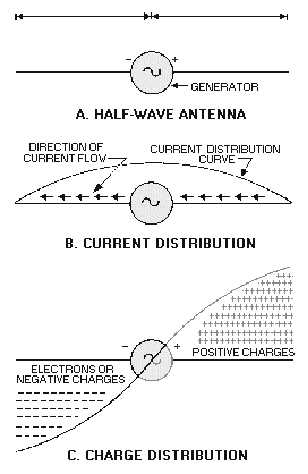4-5
Figure 4-4 shows the current and voltage distribution on a half-wave (Hertz) antenna. In view A, a
piece of wire is cut in half and attached to the terminals of a high-frequency ac generator. The frequency
of the generator is set so that each half of the wire is 1/4 wavelength of the output. The result is a common
type of antenna known as a DIPOLE.
Figure 4-4.—Current and voltage distribution on an antenna.
At a given time the right side of the generator is positive and the left side negative. Remember that
like charges repel. Because of this, electrons will flow away from the negative terminal as far as possible,
but will be attracted to the positive terminal. View B shows the direction and distribution of electron flow.
The distribution curve shows that most current flows in the center and none flows at the ends. The current
distribution over the antenna will always be the same no matter how much or how little current is flowing.
However, current at any given point on the antenna will vary directly with the amount of voltage
developed by the generator.
One-quarter cycle after electrons have begun to flow, the generator will develop its maximum
voltage and the current will decrease to 0. At that time the condition shown in view C will exist. No
current will be flowing, but a maximum number of electrons will be at the left end of the line and a
minimum number at the right end. The charge distribution view C along the wire will vary as the voltage
of the generator varies. Therefore, you may draw the following conclusions:


